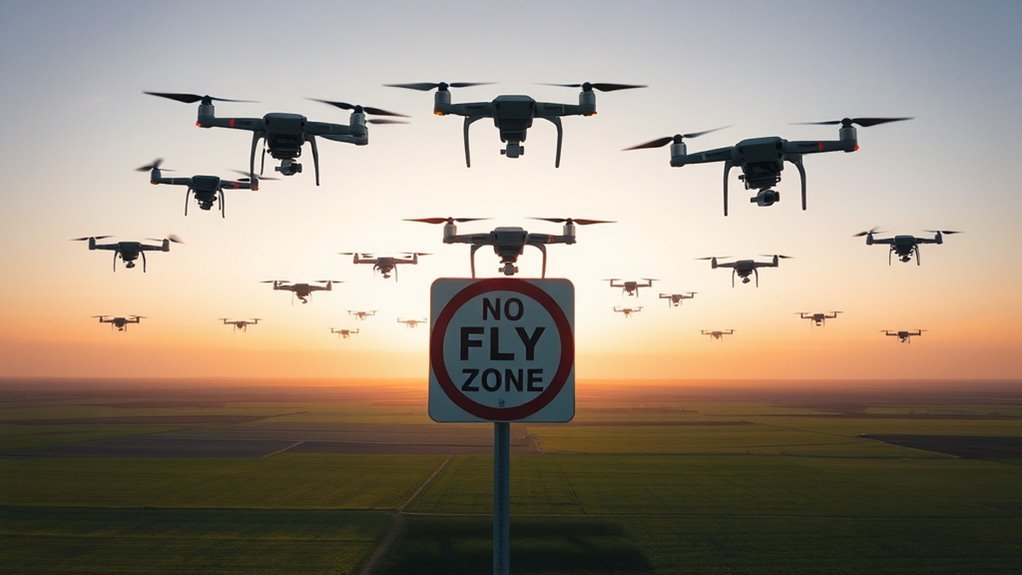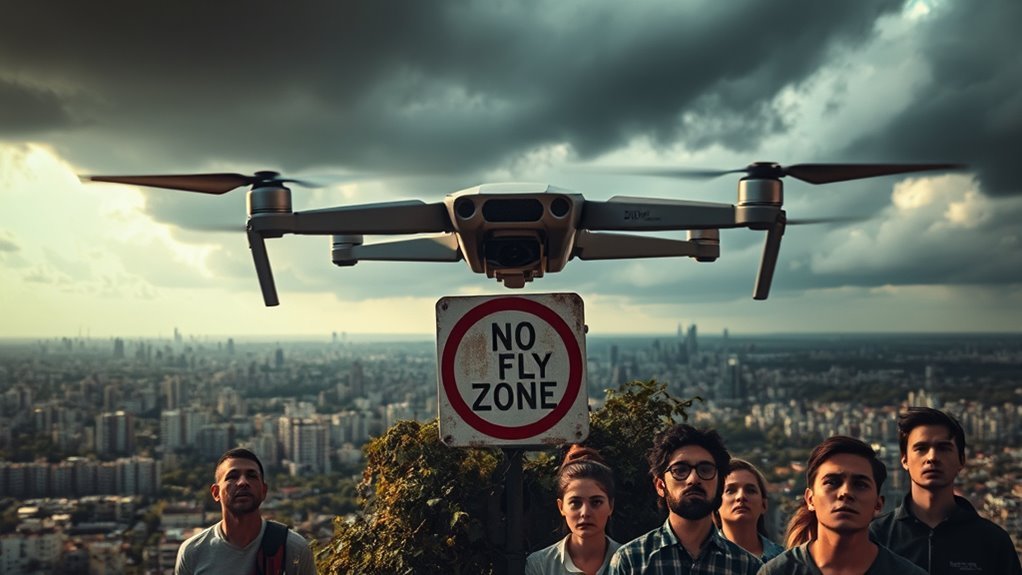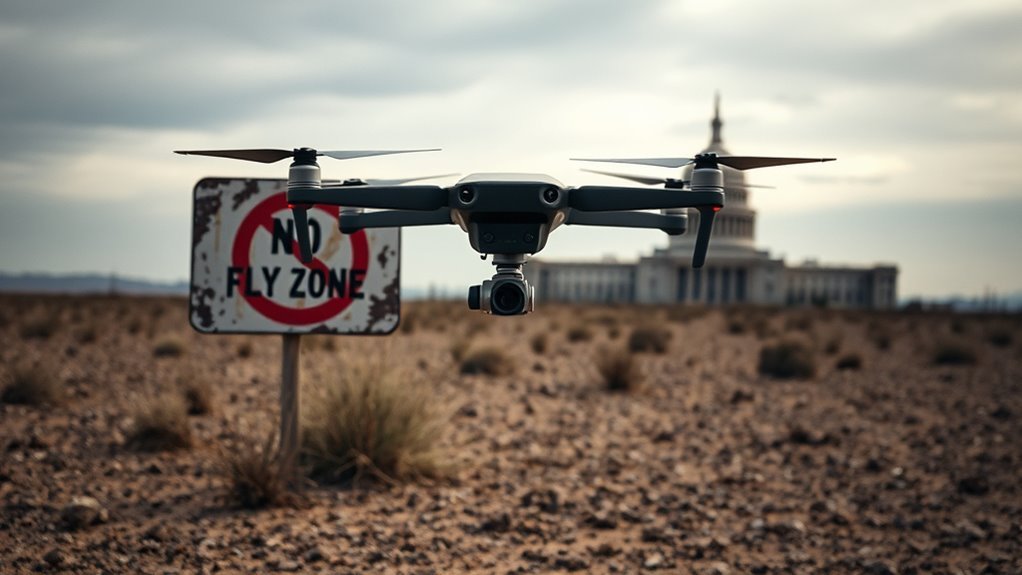DJI drones are banned worldwide mainly due to significant privacy and data security concerns. Governments worry about how user data is collected and stored, fearing unauthorized access and potential government surveillance linked to the Chinese government. Such issues undermine user trust and raise national security risks, prompting restrictions. As the drone market evolves, exploring the implications of these bans could illuminate future developments and the changing landscape of drone technology and regulations.
Overview of DJI Drones

DJI drones have carved out a significant niche in the aerial technology market, known for their innovative features and user-friendly design. Their impressive drone capabilities make them a popular choice for both hobbyists and professionals. You’ll find advanced stabilization systems, high-resolution cameras, and automated flight modes that enhance user experience. DJI features like obstacle avoidance and intelligent flight modes empower you to capture stunning aerial footage without extensive training. The combination of portability and robust performance allows you to explore creative possibilities. Furthermore, DJI’s commitment to software updates guarantees that your drone remains at the forefront of technology. Ultimately, these elements contribute to a sense of freedom, enabling you to navigate the skies with confidence and creativity. Additionally, DJI’s advanced stabilization technology redefines aerial footage capture, minimizing usual hassles for users. The Mavic 3 Pro’s endurance offers enhanced mission efficiency, allowing for longer exploration sessions without interruptions.
Privacy Concerns and Data Security

As concerns about privacy and data security grow, the implications of using DJI drones have come under increased scrutiny. Users must consider several critical factors:
- Data Privacy: How is your personal information stored and used?
- Security Breaches: Are the drones vulnerable to hacking or unauthorized access?
- User Consent: Are you fully informed about what data is collected? Furthermore, implementing advanced AI integration can help in identifying vulnerabilities and enhancing user security measures.
These issues intersect with broader ethical considerations surrounding surveillance technology. While data encryption can mitigate risks, transparency standards often fall short, leaving users uncertain. A thorough risk assessment of these drones is essential to weigh the benefits against potential threats. Ultimately, your freedom to use such technology should not come at the expense of your privacy and security. Furthermore, integrating predictive risk assessment can enhance your understanding of potential vulnerabilities associated with drone usage.
Government Bans and Restrictions

Growing concerns about privacy and data security have prompted various governments to impose bans and restrictions on the use of DJI drones. These government policies aren’t just about protecting citizens; they reflect broader anxieties regarding international relations. Countries fear that using DJI drones could compromise sensitive information, especially in an environment where geopolitical tensions influence trust. Each ban or restriction is often a strategic move, aiming to safeguard national security while maneuvering the complexities of global politics. While these measures may seem protective, they also limit the freedom of individuals and businesses seeking to innovate and utilize drone technology. As a result, the implications of these bans extend far beyond the domain of personal privacy, impacting economic opportunities and technological advancements. Moreover, a potential US ban on DJI can reshape the drone industry’s long-term landscape, providing opportunities for building market resilience through supply chain diversification and domestic manufacturing.
Allegations of Ties to Chinese Government
Concerns about DJI drones often center around their alleged ties to the Chinese government, raising questions about government surveillance capabilities. If these claims hold any truth, the national security implications could be significant, particularly for countries wary of foreign influence. As you evaluate the situation, consider how these allegations impact public trust and regulatory responses.
Government Surveillance Concerns
While many drone enthusiasts appreciate the technological advancements offered by DJI, ongoing allegations regarding the company’s ties to the Chinese government have sparked significant worry about potential government surveillance. You might find it unsettling that these concerns revolve around the following issues:
- Surveillance Technology: DJI drones are equipped with advanced cameras and sensors, raising fears about their potential use for unwarranted surveillance.
- Data Collection: The data gathered by these drones could be accessed by government entities, leading to significant privacy risks for users and citizens alike.
- Public Trust: The perception of DJI as a tool for state surveillance erodes trust, making consumers hesitant to embrace drone technology fully.
In a world that values freedom, these concerns are more than mere speculation; they demand serious consideration.
National Security Implications
As allegations of ties to the Chinese government persist, the national security implications surrounding DJI drones become increasingly pressing. You might consider how these drones could be exploited for military applications, potentially undermining the sovereignty of nations that use them. The fear of surveillance and data collection by an adversarial state raises questions about personal freedoms and the integrity of international relations. When a country’s technology could be a conduit for espionage, trust erodes, leading to heightened tensions. Nations are left grappling with the balance between technological advancement and security. Ultimately, the concern isn’t just about drones; it’s about safeguarding democratic ideals against potential foreign influence and ensuring that freedom remains paramount in an interconnected world.
Impact on Drone Enthusiasts and Users
The ban on DJI drones has created significant challenges for drone enthusiasts and users who rely on these devices for both recreational and professional purposes. This situation disrupts vibrant drone communities and intensifies hobbyist challenges in several ways:
The DJI drone ban poses serious challenges for enthusiasts, disrupting communities and stifling creativity in both recreational and professional use.
- Loss of Access: Many users can no longer access popular models, limiting their ability to capture stunning aerial footage or engage in competitive flying.
- Increased Costs: Users might face rising prices for alternative drones, making it harder to maintain their passion without breaking the bank.
- Skill Development: The ban stifles opportunities for skill enhancement, as enthusiasts are unable to practice with widely used equipment, undermining their growth in the field.
- Limited Choices: With the absence of DJI options, users may need to consider budget drones that offer different features, which could affect their flying experience and capabilities.
Ultimately, these restrictions threaten to diminish the freedom and creativity that define the drone hobbyist experience.
Industry Reactions and Alternatives
As the ban on DJI drones unfolds, industry stakeholders are rapidly formulating regulatory response strategies to navigate this new landscape. You’ll notice a surge in emerging drone technologies, with companies enthusiastically stepping in to fill the void left by DJI. It’s essential to analyze how these shifts might redefine market dynamics and user preferences moving forward. This transformation aligns with the trend of aggressive pricing strategies that allow new entrants to capture market share from established players. Additionally, the focus on NDAA compliance ensures that new technologies can operate securely and gain trust in the market.
Regulatory Response Strategies
While the global ban on DJI drones has sent shockwaves through the industry, companies and regulators are quickly mobilizing to formulate effective response strategies. To navigate this landscape, consider these three key approaches:
- Developing Compliance Frameworks: Companies are working to align their products with updated compliance frameworks that adhere to international standards, ensuring safety and security.
- Investing in R&D: Businesses are ramping up research and development to create alternative drone technologies that meet regulatory requirements while enhancing user freedom.
- Engaging with Policymakers: Industry leaders are actively engaging with regulators to shape policies that reflect both innovation and public safety, fostering a collaborative environment.
These strategies aim to not only mitigate risks but also uphold the principles of freedom and innovation in drone technology.
Emerging Drone Technologies
Given the global ban on DJI drones, industry players are pivoting towards innovative alternatives that not only comply with new regulations but also enhance operational capabilities. Companies are investing in autonomous systems that offer greater control and reliability, ensuring that users can operate within evolving legal frameworks. Aerial innovations such as enhanced battery life, obstacle detection, and advanced imaging technologies are gaining traction, empowering users with tools that can perform complex tasks efficiently. Additionally, manufacturers are focusing on open-source platforms, allowing for customization and adaptability, which appeals to those who value freedom in their operations. As the market shifts, these emerging technologies promise to redefine how you engage with aerial applications, fostering a new era of drone usage.
The Future of Drone Regulations and Technology
With the rapid evolution of drone technology, regulatory frameworks are struggling to keep pace, creating a landscape fraught with challenges and opportunities. As you navigate this intricate environment, consider the following:
- Adaptive Regulations: Policymakers need to embrace flexibility in regulations to accommodate ongoing drone innovations. This includes understanding local government regulations that can vary significantly between different areas.
- Public Engagement: Engaging communities in discussions about drone usage can foster understanding and alleviate fears related to privacy and safety.
- Technological Integration: Advancements such as AI and geofencing must be integrated into regulatory practices to enhance safety without stifling progress. The integration of advanced security protocols is crucial to build trust and protect sensitive information in the evolving drone landscape.
Ultimately, the future of drone regulations hinges on balancing freedom with responsibility, ensuring that innovation thrives while addressing the regulatory challenges that come with it.
Frequently Asked Questions
What Are the Most Popular DJI Drone Models Currently Available?
Currently, the most popular DJI drone models include the Mavic Air 2, Mini 2, and Phantom 4 Pro. These models showcase DJI innovations and impressive drone features, offering users enhanced flight capabilities and stunning aerial photography options.
How Do DJI Drones Compare to Competitors in Performance?
Imagine a race where every drone’s speed and agility matters; DJI’s performance analysis often shows it outpaces competitors. In a detailed competitor comparison, you’ll find its technology and stability provide unparalleled freedom for aerial exploration.
Are There Any Legal Alternatives to DJI Drones?
If you’re seeking legal drone options, consider alternative drone brands like Autel Robotics or Skydio. They often provide impressive features and performance, allowing you to explore aerial photography with fewer regulatory concerns than DJI.
What Are the Technical Specifications of DJI Drones?
When exploring DJI drones, you’ll find impressive drone features like advanced stabilization systems and intelligent flight modes. Their camera capabilities often include 4K video, high-resolution stills, and exceptional low-light performance, enhancing your aerial photography experience considerably.
How Can Users Ensure Compliance With Drone Regulations?
To guarantee compliance with drone regulations, you should prioritize drone education and regularly check regulation updates. Staying informed empowers you to navigate legal landscapes effectively, allowing you to enjoy your flying experience without unnecessary restrictions.

